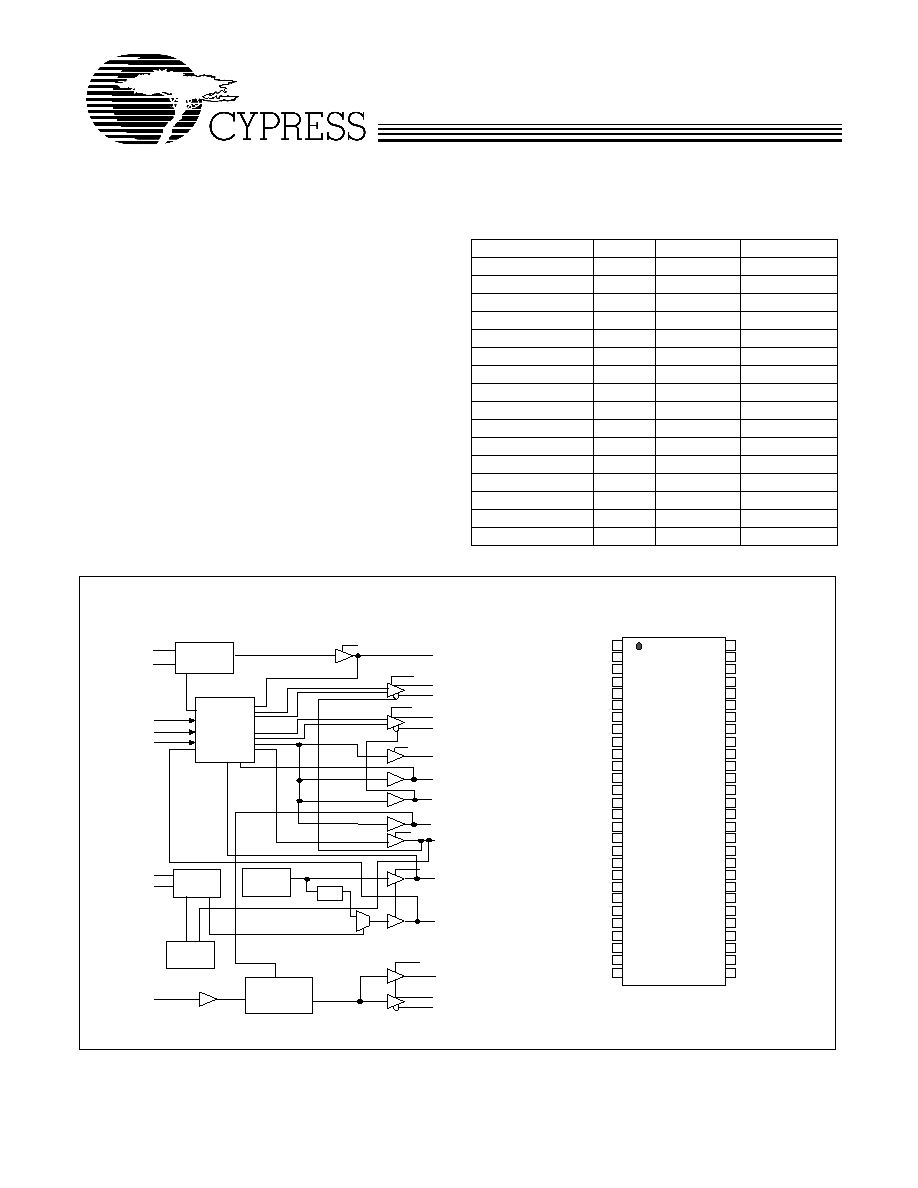 | –≠–ª–µ–∫—Ç—Ä–æ–Ω–Ω—ã–π –∫–æ–º–ø–æ–Ω–µ–Ω—Ç: CY28347ZC | –°–∫–∞—á–∞—Ç—å:  PDF PDF  ZIP ZIP |

Universal Single-chip Clock Solution
for VIA P4M266/KM266 DDR Systems
CY28347
Cypress Semiconductor Corporation
∑
3901 North First Street
∑
San Jose
,
CA 95134
∑
408-943-2600
Document #: 38-07352 Rev. *C
Revised December 26, 2002
Features
∑ Supports VIA P4M266/KM266 chipsets
∑ Supports Pentium
Æ
4, Athlon
processors
∑ Supports two DDR DIMMS
∑ Provides
-- Two different programmable CPU clock pairs
-- Six differential DDR SDRAM pairs
-- Two low-skew/low-jitter AGP clocks
-- Six low-skew/low-jitter PCI clocks
-- One 48M output for USB
-- One programmable 24M or 48M for SIO
∑ Dial-a-Frequency
and Dial-a-dB
features
∑ Spread Spectrum for best electromagnetic interference
(EMI) reduction
∑ SMBus-compatible for programmability
∑ 56-pin SSOP and TSSOP packages
Note:
1.
Pins marked with [*] have internal pull-up resistors. Pins marked with [**] have internal pull-down resistors.
Table 1. Frequency Selection Table
FS(3:0)
CPU
AGP
PCI
0000
66.80
66.80
33.40
0001
100.20
66.80
33.40
0010
120.00
60.00
30.00
0011
133.33
66.67
33.33
0100
72.00
72.00
36.00
0101
105.00
70.00
35.00
0110
160.00
64.00
32.00
0111
140.00
70.00
35.00
1000
77.00
77.00
38.50
1001
110.00
73.33
36.67
1010
180.00
60.00
30.00
1011
150.00
60.00
30.00
1100
90.00
60.00
30.00
1101
100.00
66.67
33.33
1110
200.00
66.67
33.33
1111
133.33
66.67
33.33
Block Diagram
Pin Configuration
[1]
VSSR
*FS0/REF0
XIN
XOUT
VDDAGP
*MODE/AGP0
*SELP4_K7#/AGP1
VSSAGP
*PCI_STP#
PCI1
*MULTSEL/PCI2
VSSPCI
PCI3
PCI4
VDDPCI
PCI5
*CPU_STP#
VSS48M
**FS3/48M
**FS2/24_48M
VDD48M
VDD
VSS
IREF
*PD#
SCLK
SDATA
**FS1/PCI_F
VDDR
VTTPWRGD#/REF1
VSSC
CPUT/CPUOD_T
CPUC/CPUOD_C
VDDC
VDDI
CPUCS_T
CPUCS_C
FBOUT
BUF_IN
DDRT0
DDRC0
DDRT1
DDRC1
VDDD
VSSD
DDRT2
DDRC2
DDRT3
DDRC3
VDDD
VSSD
DDRT4
DDRC4
DDRT5
DDRC5
VSSI
CY
2
834
7
8
9
10
11
12
13
14
15
16
17
18
19
20
21
22
23
24
25
26
27
28
1
2
3
4
5
6
7
56
55
54
53
52
51
50
49
48
47
46
45
44
43
42
41
40
39
38
37
36
35
34
33
32
31
30
29
PLL1
S2D
CONVERT
SMBus
CPUCS_T
VDDC
VDDI
CPUT/CPU0D_T
SELP4_K7#
PCI(3:5)
PCI_F
FS1
REF(0:1)
VDDR
FS0
48M
24_48M
FBOUT
DDRT(0:5)
SCLK
SDATA
PD#
AGP(0:1)
VDDAGP
VDD48M
VDDD
XTAL
XOUT
XIN
FS2
PCI2
PCI1
VDDPCI
PLL2
/ 2
BUF_IN
REF0
FS3
MULTSEL
SELSDR_DDR#
DDRC(0:5)
CPU_STP#
PCI_STP#
CPUCS_C
CPUC/CPU0D_C

CY28347
Document #: 38-07352 Rev. *C
Page 2 of 22
Pin Description
[2]
Pin
Name
PWR
I/O
Description
3
XIN
I
Oscillator Buffer Input. Connect to a crystal or to an external clock.
4
XOUT
VDD
O
Oscillator Buffer Output. Connect to a crystal. Do not connect when an external
clock is applied at XIN.
1
FS0/REF0
VDD
I/O
PU
Power-on Bidirectional Input/Output. At power-up, FS0 is the input. When the
power supply voltage crosses the input threshold voltage, FS0 state is latched and
this pin becomes REF0, buffered copy of signal applied at XIN. (1≠2 x strength,
selectable by SMBus. Default value is 1 x strength.)
56
VTTPWRGD# VDDR
I
If SELP4_K7# = 1, with a P4 processor setup as CPU(T:C). At power-up,
VTT_PWRGD# is an input. When this input is sampled LOW, the FS (3:0) and
MULTSEL are latched and all output clocks are enabled. After the first transition to
a LOW on VTT_PWRGD#, this pin is ignored and will not effect the behavior of the
device thereafter. When the VTT_PWRGD# feature is not used, please connect this
signal to ground through a 10K
resistor.
REF1
VDDR
O
If SELP4_K7# = 0, with an Athlon (K7) processor as CPUOD_(T:C).
VTT_PWRGD# function is disabled, and the feature is ignored. This pin becomes
REF1 and is a buffered copy of the signal applied at XIN.
44,42,38,
36,32,30
DDRT(0:5)
VDDD
O
These pins are configured for DDR clock outputs. They are "True" copies of
signal applied at Pin45, BUF_IN.
43,41,37
35,31,29
DDRC(0:5)
VDDD
O
These pins are configured for DDR clock outputs. They are "Complementary"
copies of signal applied at Pin45, BUF_IN.
7
SELP4_K7#/
AGP1
VDDAGP I/O
PU
Power-on Bidirectional Input/Output. At power-up, SELP4_K7# is the input.
When the power supply voltage crosses the input threshold voltage, SELP4_K7#
state is latched and this pin becomes AGP1 clock output. SELP4_K7# = 1 selects
P4 mode. SELP4_K7# = 0 selects K7 mode.
12
MULTSEL/PCI2 VDDPCI
I/O
PU
Power-on Bidirectional Input/Output. At power-up, MULTSEL is the input. When
the power supply voltage crosses the input threshold voltage, MULTSEL state is
latched and this pin becomes PCI2 clock output. MULTSEL = 0, Ioh is 4 x
IREFMULTSEL = 1, Ioh is 6 x IREF
53
CPUT/CPUOD_T
VDDC
O
3.3V True CPU Clock Outputs. This pin is programmable through strapping pin7,
SELP4_K7#. If SELP4_K7# = 1, this pin is configured as the CPUT Clock Output.
If SELP4_K7# = 0, this pin is configured as the CPUOD_T Open Drain Clock Output.
See Table 1.
52
CPUC/CPUOD_C
VDDC
O
3.3V Complementary CPU Clock Outputs. This pin is programmable through
strapping pin7, SELP4_K7#. If SELP4_K7# = 1, this pin is configured as the CPUC
Clock Output. If SELP4_K7# = 0, this pin is configured as the CPUOD_C Open
Drain Clock Output. See Table 1.
14,15,17
PCI (3:5)
VDDPCI
O
PCI Clock Outputs. Are synchronous to CPU clocks. See Table 1.
48,49
CPUCS_T/C
VDDI
O
2.5V CPU Clock Outputs for Chipset. See Table 1.
18
CPU_STP#
VDDPCI
I
PU
If pin 6 is pulled down at power on reset, then this pin becomes CPU_STP#. When
CPU_STP# is asserted LOW, then both of the CPU signals stop at the next HIGH
to LOW transition or stays LOW if it already is LOW. This does not stop the CPUCS
signals.
10
FS1/PCI_F
VDDPCI
I/O
PD
Power-on Bidirectional Input/Output. At power-up, FS1 is the input. When the
power supply voltage crosses the input threshold voltage, FS1 state is latched and
this pin becomes PCI_F clock output.
20
FS3/48M
VDD48M
I/O
PD
Power-on Bidirectional Input/Output. At power-up, FS3 is the input. When the
power supply voltage crosses the input threshold voltage, FS3 state is latched and
this pin becomes 48M, a USB clock output.
11
PCI1
VDDPCI
O
PCI Clock Output.
21
FS2/24_48M
VDD48M
I/O
PD
Power-on Bidirectional Input/Output. At power-up, FS2 is the input. When the
power supply voltage crosses the input threshold voltage, FS2 state is latched and
this pin becomes 24_48M, a SIO programmable clock output.
Note:
2.
PU = internal pull-up. PD = internal pull-down. Typically = 250 k
(range 200 k
to 500 k
).

CY28347
Document #: 38-07352 Rev. *C
Page 3 of 22
6
MODE/AGP0
VDDAGP I/O
PU
Power-on Bidirectional Input/Output. At power-up, MODE is an input and
becomes AGP0 output after the power supply voltage crosses the input threshold
voltage. Must have 10K
resistor to V
SS
. See Table 2.
8
PCI_STP#
VDDAGP
I
PU
If pin 6 is pulled down at power on reset, then this pin becomes PCI_STP#.
When PCI_STP# is asserted LOW, then all of the PCI signals, except the PCI_F,
stops at the next HIGH to LOW transition or stays LOW if it already is LOW.
25
IREF
I
Current reference programming input for CPU buffers. A precise resistor is
attached to this pin, which is connected to the internal current reference.
28
SDATA
I/O Serial Data Input. Conforms to the SMBus specification of a Slave
Receive/Transmit device. It is an input when receiving data. It is an open drain output
when acknowledging or transmitting data.
27
SCLK
I
Serial Clock Input. Conforms to the SMBus specification.
26
PD#
I
PU
When PD# is asserted LOW, the device enters power down mode. See power
management function.
45
BUF_IN
I
2.5V CMOS type input to the DDR differential buffers.
46
FBOUT
O
This is the single-ended, SDRAM buffered output of the signal applied at
BUF_IN. It is in phase with the DDRT(0:5) signals.
5
VDDAGP
3.3V power supply for AGP clocks.
51
VDDC
3.3V power supply for CPU (T: C) clocks.
16
VDDPCI
3.3V power supply for PCI clocks.
55
VDDR
3.3V power supply for REF clock.
50
VDDI
2.5V power supply for CPUCS_T/C clocks.
22
VDD48M
3.3V power supply for 48M.
23
VDD
3.3V Common power supply.
34,40
VDDD
2.5V power supply for DDR clocks.
9
VSSAGP
Ground for AGP clocks.
13
VSSPCI
Ground for PCI clocks.
54
VSSC
Ground for CPU (T:C) clocks.
33,39
VSSD
Ground for DDR clocks.
19
VSS48M
Ground for 48M clock.
47
VSSI
Ground for CPUCS_T/C clocks.
24
VSS
Common ground.
Pin Description
(continued)
[2]
Pin
Name
PWR
I/O
Description
Table 2. MODE Pin-Power Management Input Control
MODE, Pin 6
(Latched Input)
Pin 26
Pin 18
Pin 8
0
PD#
CPU_STP#
PCI_STP#
Invalid
Reserved
Reserved
Reserved
Table 3. Swing Select Functions Through Hardware
MULTSEL
Board Target
Trace/Term Z
Reference R,
IREF = VDD/(3*Rr)
Output Current
VOH@Z
0
50 Ohm
Rr = 221 1%,
IREF = 5.00 mA
IOH = 4* Iref
1.0V@50
1
50 Ohm
Rr = 475 1%,
IREF = 2.32 mA
IOH = 6* Iref
0.7V@50

CY28347
Document #: 38-07352 Rev. *C
Page 4 of 22
Serial Data Interface
To enhance the flexibility and function of the clock synthesizer,
a two-signal serial interface is provided. Through the Serial
Data Interface, various device functions such as individual
clock output buffers, etc., can be individually enabled or
disabled.
The registers associated with the Serial Data Interface
initializes to their default setting upon power-up, and therefore
use of this interface is optional. Clock device register changes
are normally made upon system initialization, if any are
required. The interface can also be used during system
operation for power management functions.
Data Protocol
The clock driver serial protocol accepts Byte Write, Byte Read,
Block Write, and Block Read operation from the controller. For
Block Write/Read operation, the bytes must be accessed in
sequential order from lowest to highest byte (most significant
bit first) with the ability to stop after any complete byte has
been transferred. For Byte Write and Byte Read operations,
the system controller can access individual indexed bytes. The
offset of the indexed byte is encoded in the command code,
as described in Table 4.
The Block Write and Block Read protocol is outlined in Table 5
while Table 6 outlines the corresponding Byte Write and Byte
Read protocol. The slave receiver address is 11010010 (D2H).
Table 4. Command Code Definition
Bit
Description
7
0 = Block Read or Block Write operation
1 = Byte Read or Byte Write operation
(6:0)
Byte offset for Byte Read or Byte Write operation. For Block Read or Block Write operations, these bits
should be "0000000"
Table 5. Block Read and Block Write Protocol
Block Write Protocol
Block Read Protocol
Bit
Description
Bit
Description
1
Start
1
Start
2:8
Slave address - 7 bits
2:8
Slave address - 7 bits
9
Write
9
Write
10
Acknowledge from slave
10
Acknowledge from slave
11:18
Command Code - 8 Bit "00000000" stands for block
operation
11:18
Command Code - 8 Bit "00000000" stands for block
operation
19
Acknowledge from slave
19
Acknowledge from slave
20:27
Byte Count - 8 bits
20
Repeat start
28
Acknowledge from slave
21:27
Slave address - 7 bits
29:36
Data byte 0 - 8 bits
28
Read
37
Acknowledge from slave
29
Acknowledge from slave
38:45
Data byte 1 - 8 bits
30:37
Byte count from slave - 8 bits
46
Acknowledge from slave
38
Acknowledge
....
Data Byte N/Slave Acknowledge...
39:46
Data byte from slave - 8 bits
....
Data Byte N - 8 bits
47
Acknowledge
....
Acknowledge from slave
48:55
Data byte from slave - 8 bits
....
Stop
56
Acknowledge
....
Data bytes from slave/Acknowledge
....
Data byte N from slave - 8 bits
....
Not Acknowledge
....
Stop
Table 6. Byte Read and Byte Write Protocol
Byte Write Protocol
Byte Read Protocol
Bit
Description
Bit
Description
1
Start
1
Start
2:8
Slave address - 7 bits
2:8
Slave address - 7 bits
9
Write
9
Write

CY28347
Document #: 38-07352 Rev. *C
Page 5 of 22
10
Acknowledge from slave
10
Acknowledge from slave
11:18
Command Code - 8 bits "1xxxxxxx" stands for byte
operation bit[6:0] of the command code represents
the offset of the byte to be accessed
11:18
Command Code - 8 bits "1xxxxxxx" stands for byte
operation bit[6:0] of the command code represents
the offset of the byte to be accessed
19
Acknowledge from slave
19
Acknowledge from slave
20:27
Data Byte from Master ≠ 8 Bits
20
Repeat start
28
Acknowledge from slave
21:27
Slave address - 7 bits
29
Stop
28
Read
29
Acknowledge from slave
30:37
Data byte from slave - 8 bits
38
Not Acknowledge
39
Stop
Table 6. Byte Read and Byte Write Protocol (continued)
Byte 0: Frequency Select Register
Bit
@Pup
Pin#
Name
Description
7
0
Reserved.
6
H/W Setting
21
FS2
For Selecting Frequencies see Table 1.
5
H/W Setting
10
FS1
For Selecting Frequencies see Table 1.
4
H/W Setting
1
FS0
For Selecting Frequencies see Table 1.
3
0
If this bit is programmed to "1," it enables WRITES to bits (6:4,1) for
selecting the frequency via software (SMBus)
If this bit is programmed to a "0" it enables only READS of bits
(6:4,1), which reflect the hardware setting of FS(0:3).
2
H/W Setting
11
Reserved
Reserved
1
H/W Setting
20
FS3
For Selecting frequencies in Table 1.
0
H/W Setting
7
SELP4_K7#
Only for reading the hardware setting of the CPU interface mode,
status of SELP4_K7# strapping.
Byte 1: CPU Clocks Register
Bit
@Pup
Pin#
Name
Description
7
0
SSMODE
0 = Down Spread. 1 = Center Spread. See Table 9.
6
1
SSCG
1 = Enable (default). 0 = Disable
5
1
SST1
Select spread bandwidth. See Table 9.
4
1
SST0
Select spread bandwidth. See Table 9.
3
1
48,49
CPUCS_T/C_ EN#
1 = output enabled (running). 0 = output disabled asynchronously
in a LOW state.
2
1
53,52
CPUOD_T/C_EN#
1 = output enabled (running). 0 = output disable asynchronously
in a LOW state.
1
0
53,52
CPUT/C_PD_CNTRL
In K7 mode, this bit is ignored. In P4 mode, when PD# asserted
LOW, 0 = drive CPUT to 2xIref and CPUC LOW and
1 = three-state CPUT and CPUC.
0
1
11
MULT0
Only For reading the hardware setting of the Pin11 MULT0 value.
Byte 2: PCI Clock Register
Bit
@Pup
Pin#
Name
Description
7
0
PCI_DRV
PCI clock output drive strength 0 = Normal, 1 = increase the drive
strength 20%.
6
1
10
PCI_F
1 = output enabled (running). 0 = output disabled asynchronously
in a LOW state.
5
1
Reserved, set = 1.




